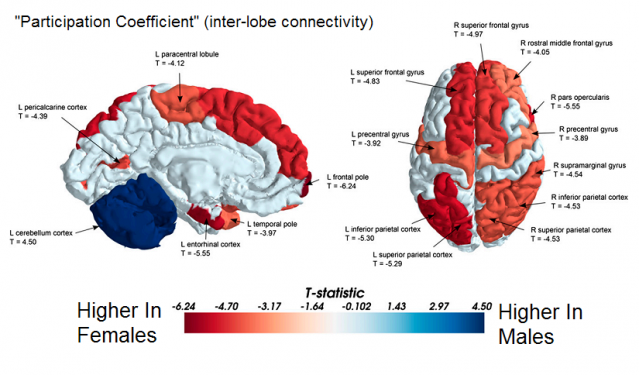Neuroscience
Brain Connectivity Varies Between Men and Women
Scientists discover striking differences in neural wiring based on gender.
Posted December 3, 2013

The top two brains are male, the bottom two female.
Researchers at University of Pennsylvania have discovered fundamental differences between the neural wiring of the male and female brain. The human brain has four hemispheres—two in the cerebrum and two in the cerebellum. This is one of the largest studies to analyze the "connectomes" between—and within—each of the brain’s four hemispheres.
Major intra- and inter-connective differences were found in the left and right hemispheres of both the cerebrum and the cerebellum depending on gender. Past studies have shown sex differences in the brain, but the neural wiring connecting regions across the whole brain had never been studied in a large population until now.
The Penn Medicine study titled, "Sex Differences in the Structural Connectome of the Human Brain," was published December 2, 2013 in the Proceedings of National Academy of Sciences.
Ragini Verma, PhD, an associate professor in the department of Radiology at the Perelman School of Medicine at the University of Pennsylvania, and colleagues, found greater neural connectivity from front to back and within one hemisphere in males. This suggests that the male brain may be structured to facilitate greater connectivity between perception and coordinated action.
In females, the researchers found that the wiring was generally greater between the left and right hemispheres. This connectivity facilitates communication between the analytical and intuitive. "These maps show us a stark difference—and complementarity in the architecture of the human brain that helps provide a potential neural basis as to why men excel at certain tasks, and women at others," according to Verma.
For this study, Verma and colleagues investigated the gender-specific differences in brain connectivity during the course of development in 949 individuals (521 females and 428 males) aged 8 to 22 years using diffusion tensor imaging (DTI). DTI is water-based imaging technique that can trace and highlight the fiber pathways connecting the different regions of the brain, laying the foundation for a structural connectome or network of the whole brain.
Gender May Dictate Inter and Intra Brain Connectivity

Each individual's brain is an intricate and unique system of neural pathways that connect multiple networks within the cerebrum to several sub-networks in the cerebellum. The mysterious and powerful cerebellum is only 10% of brain volume but houses over 50% of your brain’s total neurons. Neuroscientists are still perplexed by the many functions of the cerebellum and why it has so many neurons.
My father—who was a neurosurgeon and neuroscientist—always said, "Whatever the cerebellum is doing, it's doing a lot of it." This study offers some interesting clues on the various roles of the cerebellum based on gender.
In this study, the researchers found that females displayed greater connectivity between the left and right hemispheres of the cerebrum. Males, on the other hand, displayed greater connectivity within each of the two hemispheres of the cerebrum.
On the flip side, the opposite occurred in the cerebellum where males displayed greater inter-hemispheric connectivity and females displayed greater intra-hemispheric connectivity.
The researchers believe these connections may give men an efficient system for coordinated action, where the cerebellum and cerebrum participate in bridging perceptual experiences in the back of the brain, and action, in the front of the brain. The female connections likely facilitate integration of the analytic and sequential processing modes of the left hemisphere with the spatial, intuitive information processing modes of the right side, according to the authors.

These findings were consistent with another Penn behavior study that demonstrated pronounced differences between the sexes. In that study females outperformed males on attention, word and face memory, and social cognition tests. Males performed better on spatial processing and sensorimotor speed. Those differences were most pronounced in the 12 to 14 age range.
Conclusion: Male and Female Brains Are Complementary and Varied
Next steps for the researchers will be to quantify how an individual's neural connections differ from the larger population to make each person unique. The researchers want to identify which neural connections are gender specific and which are the same in both men and women. Although this study makes some sweeping generalizations, it is interesting to note statistical patterns of connectivity that vary between the sexes.
Dr. Ruben Gur, a co-author of the study, concludes, "It's quite striking how complementary the brains of women and men really are. Detailed connectome maps of the brain will not only help us better understand the differences between how men and women think, but it will also give us more insight into the roots of neurological disorders, which are often sex related."
If you’d like to read more on this topic, please check out my Psychology Today blog posts:
- “Neuroscientists Discover Why Men Are From Mars”
- "One More Reason to Unplug Your Television"
- “Unique Gene Combinations Reshape Our Brains and Behaviors”
- “Autism Gene Can Disrupt Connections Between Brain Regions”
- “Decoding the Secrets of Brain Connectivity”
- “The "Right Brain” Is Not the Only Source of Creativity”
- “How Is the Cerebellum Linked to Autism Spectrum Disorders?”
- “What Is the Human Connectome Project? Why Should You Care?”
Follow me on Twitter @ckbergland for updates on The Athlete’s Way blog posts.




